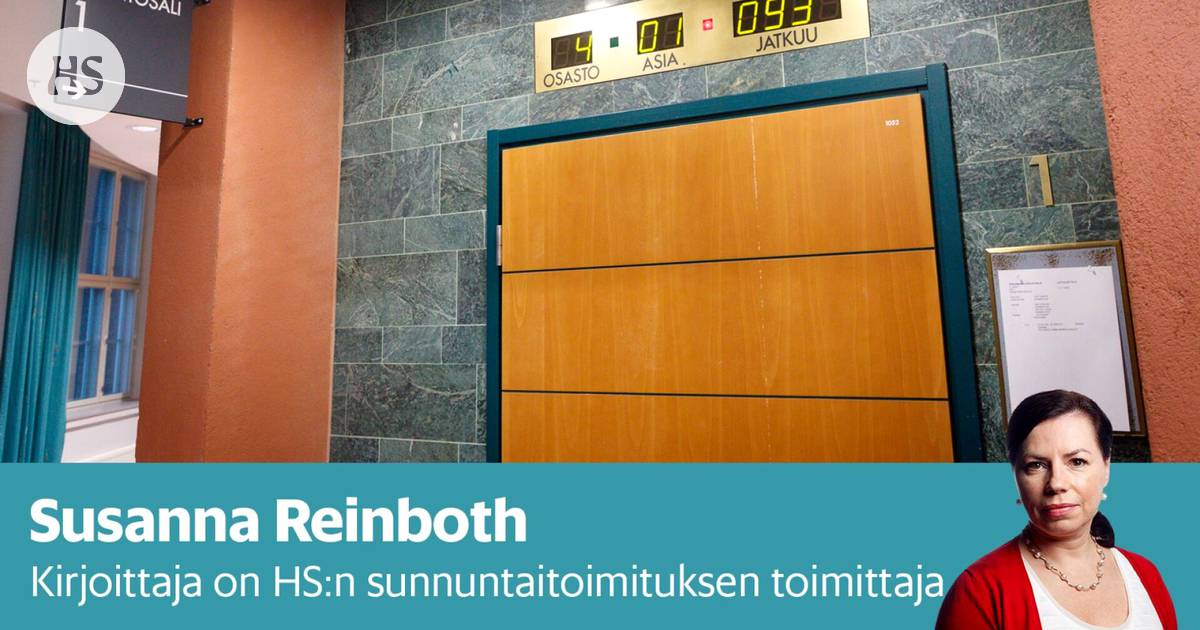Within a week, three murders or attempted murders were heard in the courts, all behind closed doors. Has the exception become the rule, asks legal reporter Susanna Reinboth.
Prosecutor demanded that a 91-year-old well-to-do man be punished for murdering his wife with a hammer.
In the district court of Porvoo, Itä-Uusimaa, the mother was charged with attempted murder of her 5-year-old child.
A taxi driver was charged with aggravated rape and murder of a female taxi driver in Asikkala.
In March, in just one week, the courts began to deal with three murders or attempted murders.
The three cases have one thing in common: the public had no business being in the courtroom to watch the proceedings.
This is exceptional, as the trials are emphatically public. This especially applies to criminal cases, because in them the authorities can interfere significantly with the basic rights of an individual. For example, the court can deprive someone of their freedom for years. Such use of public power must be able to be monitored.
In these in three cases, the courts justified the concealment by, among other things, the protection of the private life and health information of the participants.
The protection of private life and health information is indeed one reason for limiting the publicity of the trial. However, any matter related to private life does not make the session secret, but the matter must be sensitive.
According to the law, even this is not enough to encrypt data. If sensitive facts are essentially related to the act referred to in the indictment or its criminal evaluation, they are public.
In this case, the court can make a separate decision to conceal individual information or even the entire case. This is often done, for example, in sexual crime cases. Then you want to protect the victim of a sensitive crime. Even then, the information about the accused and the outcome of the case is always public.
Matters related to private life usually come to light in the homicide case as well. Often they are related to the motive, i.e. why the crime has taken place.
Especially a lot of information related to private life is revealed in acts of violence within the family. If the courtroom doors were closed every time something related to private life came to light, more than half of the murders against women would be handled in secret. A woman’s killer is most often a former or current partner.
The legislator clearly did not intend for the law to be interpreted this way. If there was, it would be visible in the documents related to the preparation of the law.
This has also been emphasized by the ombudsman Petri Jääskeläinen. In 2009, he issued a decision regarding the secret processing of a man’s marital homicide in Tampere.
Salaami had been requested by the accused man. The couple’s children also think that publicity would cause them great harm and upset, and it would also hurt their mother’s memory. The district court decided to conceal all the documents and sit the case behind closed doors.
The ombudsman gave towels about concealment.
Although the publicity decision is made in each criminal case separately, they must follow the acceptable decision line in terms of the principle of publicity of the trial, Jääskeläinen emphasized.
The ombudsman pointed out that in all homicide cases that occurred in a relationship, it is inevitable to deal with matters within the family, belonging to the spouses’ private lives. In his opinion, the issues brought up in the Tampere case were not particularly sensitive, but rather typical.
Public the purpose is to protect citizens from arbitrariness, to provide an opportunity to supervise the operation of the courts and to increase trust in the operation of the courts.
It is understandable that not all issues can be dealt with publicly. However, excessive concealment is thought provoking.
Let’s take a recent example. Anneli Aueria the sex crime case was handled behind closed doors to protect the children.
Would the outcome have been more carefully weighed if the judges had known that the public would have better visibility of their reasoning?
And how much trust in the courts is being eaten away by the fact that the alleged child victims say that the entire sentence was based on fairy tales?
Read more: The charge: the 91-year-old killed his wife, who was sitting in an armchair, with a hammer
Read more: Accusation: The mother tried to kill her child – The police saved the child by breaking the window
Read more: Charge: A man raped and strangled a taxi driver
#Analysis #Homicide #cases #sensitively #concealed #supervises #courts









